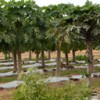 With the recent spike in papaya prices due to phytosanitary restrictions on papayas from Mexico, many growers in South Florida are considering getting back into papaya production to target the ripe papaya market. Still, there are a lot of concerns as to whether the crop can be profitable in light of declining yields. Based on this discussion, the objective of this article is to provide needed information on the costs and returns associated with establishing and operating a five-acre papaya orchard in South Florida, and to assess the prices and yields that must be obtained to make a papaya orchard profitable. This 5-page fact sheet was written by Edward A. Evans, Fredy H. Ballen, and Jonathan H. Crane, and published by the UF Department of Food and Resource Economics, December 2012.
With the recent spike in papaya prices due to phytosanitary restrictions on papayas from Mexico, many growers in South Florida are considering getting back into papaya production to target the ripe papaya market. Still, there are a lot of concerns as to whether the crop can be profitable in light of declining yields. Based on this discussion, the objective of this article is to provide needed information on the costs and returns associated with establishing and operating a five-acre papaya orchard in South Florida, and to assess the prices and yields that must be obtained to make a papaya orchard profitable. This 5-page fact sheet was written by Edward A. Evans, Fredy H. Ballen, and Jonathan H. Crane, and published by the UF Department of Food and Resource Economics, December 2012.
http://edis.ifas.ufl.edu/fe918
Category: Agriculture
Pesticide Options for Important Insect, Mite, and Mollusk Pests of Commercial Flowers in Florida (ENY695/IG162)
 Effective arthropod pest management in commercial floral crops requires that pests be detected in a timely manner through systematic scouting and that appropriate control measures be applied as conditions warrant. Control measures may include economical combinations of cultural controls, physical controls, biological controls, and chemical controls. This 9-page guide is a summary of chemical control measures that are presently available to commercial flower producers in Florida and includes beneficial nematode and microbial insecticides that also are components of biological control. Written by James F. Price and Curtis Nagle, and published by the UF Department of Entomology and Nematology, November 2012.
Effective arthropod pest management in commercial floral crops requires that pests be detected in a timely manner through systematic scouting and that appropriate control measures be applied as conditions warrant. Control measures may include economical combinations of cultural controls, physical controls, biological controls, and chemical controls. This 9-page guide is a summary of chemical control measures that are presently available to commercial flower producers in Florida and includes beneficial nematode and microbial insecticides that also are components of biological control. Written by James F. Price and Curtis Nagle, and published by the UF Department of Entomology and Nematology, November 2012.
http://edis.ifas.ufl.edu/ig162
Understanding and Applying Chelated Fertilizers Effectively Based on Soil pH (HS1208)
 Plant nutrients are one of the environmental factors essential for crop growth and development. Nutrient management is crucial for optimal productivity in commercial crop production. Those nutrients in concentrations of ≤ 100 parts per million (ppm) in plant tissues are described as micronutrients and include iron (Fe), zinc (Zn), manganese (Mn), copper (Cu), boron (B), chlorine (Cl), molybdenum (Mo), and nickel (Ni). Micronutrients such as Fe, Mn, Zn, and Cu are easily oxidized or precipitated in soil, and their utilization is, therefore, not very efficient. Chelated fertilizers have been developed to increase micronutrient utilization efficiency. This 5-page fact sheet provides an overview of chelated fertilizers and considerations for their use to county Extension faculty, growers, and students who are interested in commercial crop production. Written by Guodong Liu, Edward Hanlon, and Yuncong Li, and published by the UF Department of Horticultural Sciences, November 2012.
Plant nutrients are one of the environmental factors essential for crop growth and development. Nutrient management is crucial for optimal productivity in commercial crop production. Those nutrients in concentrations of ≤ 100 parts per million (ppm) in plant tissues are described as micronutrients and include iron (Fe), zinc (Zn), manganese (Mn), copper (Cu), boron (B), chlorine (Cl), molybdenum (Mo), and nickel (Ni). Micronutrients such as Fe, Mn, Zn, and Cu are easily oxidized or precipitated in soil, and their utilization is, therefore, not very efficient. Chelated fertilizers have been developed to increase micronutrient utilization efficiency. This 5-page fact sheet provides an overview of chelated fertilizers and considerations for their use to county Extension faculty, growers, and students who are interested in commercial crop production. Written by Guodong Liu, Edward Hanlon, and Yuncong Li, and published by the UF Department of Horticultural Sciences, November 2012.
http://edis.ifas.ufl.edu/hs1208
Rootstocks for Florida Stone Fruit (HS1110/HS366)
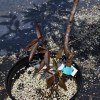 Rootstocks have been used in many tree fruit systems to provide growth advantages or pest or disease resistance without affecting productivity and fruit quality. In Florida, stone fruit are grown on rootstocks that specifically provide pest resistance to the peach root-knot nematode. Although several root-knot nematode-resistant rootstocks are available for stone fruit grown in other locations and climates, ‘Flordaguard’ peach rootstock is currently recommended for stone fruit production in Florida. This 5-page fact sheet was written by M. Olmstead, J. Chaparro, and J. Ferguson, and published by the UF Department of Horticultural Sciences, November 2012.
Rootstocks have been used in many tree fruit systems to provide growth advantages or pest or disease resistance without affecting productivity and fruit quality. In Florida, stone fruit are grown on rootstocks that specifically provide pest resistance to the peach root-knot nematode. Although several root-knot nematode-resistant rootstocks are available for stone fruit grown in other locations and climates, ‘Flordaguard’ peach rootstock is currently recommended for stone fruit production in Florida. This 5-page fact sheet was written by M. Olmstead, J. Chaparro, and J. Ferguson, and published by the UF Department of Horticultural Sciences, November 2012.
http://edis.ifas.ufl.edu/hs366
Green lacewings (of Florida) Neuroptera: Chrysopidae (EENY534/IN965)
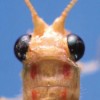 The Chrysopidae are one of the largest and economically most important families of the Neuroptera. There are about 1,300 currently recognized species included in about 87 genera and three subfamilies (Brooks and Bernard 1990) in the world. In Florida, there are 22 species in 9 genera, all placed in the subfamily Chrysopinae (Penny et al. 1997). The larvae are voracious predators of small, comparatively soft-bodied arthropods such as aphids, scale insects, whiteflies, thrips, insect eggs, and other prey (Muma 1959; Canard et al. 1984). For this reason they are used widely in biological control. The adults are usually predators, but a few species only feed on pollen. This 4-page fact sheet includes Key to the Genera of Green Lacewings of Florida. Written by Lionel A. Stange, and published by the UF Department of Entomology and Nematology, November 2012.
The Chrysopidae are one of the largest and economically most important families of the Neuroptera. There are about 1,300 currently recognized species included in about 87 genera and three subfamilies (Brooks and Bernard 1990) in the world. In Florida, there are 22 species in 9 genera, all placed in the subfamily Chrysopinae (Penny et al. 1997). The larvae are voracious predators of small, comparatively soft-bodied arthropods such as aphids, scale insects, whiteflies, thrips, insect eggs, and other prey (Muma 1959; Canard et al. 1984). For this reason they are used widely in biological control. The adults are usually predators, but a few species only feed on pollen. This 4-page fact sheet includes Key to the Genera of Green Lacewings of Florida. Written by Lionel A. Stange, and published by the UF Department of Entomology and Nematology, November 2012.
http://edis.ifas.ufl.edu/in965
Burrowing Nematode Radopholus similis (Cobb, 1893) Thorne, 1949 (Nematoda: Secernentea: Tylenchida: Pratylenchidae: Pratylenchinae) (EENY542/IN969)
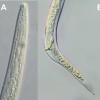 The burrowing nematode is the most economically important nematode parasite of banana in the world. Infection causes toppling disease of banana, yellows disease of pepper and spreading decline of citrus. These diseases are the result of burrowing nematode infection destroying root tissue, leaving plants with little to no support or ability to take up water and translocate nutrients. Because of the damage that it causes to citrus, ornamentals and other agricultural industries, worldwide, burrowing nematode is one of the most regulated nematode plant pests. This 5-page fact sheet was written by Nicholas Sekora and William T. Crow, and published by the UF Department of Entomology and Nematology, November 2012.
The burrowing nematode is the most economically important nematode parasite of banana in the world. Infection causes toppling disease of banana, yellows disease of pepper and spreading decline of citrus. These diseases are the result of burrowing nematode infection destroying root tissue, leaving plants with little to no support or ability to take up water and translocate nutrients. Because of the damage that it causes to citrus, ornamentals and other agricultural industries, worldwide, burrowing nematode is one of the most regulated nematode plant pests. This 5-page fact sheet was written by Nicholas Sekora and William T. Crow, and published by the UF Department of Entomology and Nematology, November 2012.
http://edis.ifas.ufl.edu/in969
Tropical sod webworm Herpetogramma phaeopteralis Guenee (Insecta: Lepidoptera: Crambidae) (EENY541/IN968)
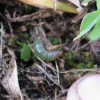 Tropical sod webworm larvae are destructive pests of warm season turfgrasses in the southeastern U.S., especially on newly established sod, lawns, athletic fields, and golf courses. Larval feeding damage reduces turfgrass aesthetics, vigor, photosynthesis and density. The first sign of damage is often caused by differences in grass height in areas where larvae are feeding. This 5-page fact sheet was written by Nastaran Tofangsazie, Steven P. Arthurs, and Ronald Cherry, and published by the UF Department of Entomology and Nematology, November 2012.
Tropical sod webworm larvae are destructive pests of warm season turfgrasses in the southeastern U.S., especially on newly established sod, lawns, athletic fields, and golf courses. Larval feeding damage reduces turfgrass aesthetics, vigor, photosynthesis and density. The first sign of damage is often caused by differences in grass height in areas where larvae are feeding. This 5-page fact sheet was written by Nastaran Tofangsazie, Steven P. Arthurs, and Ronald Cherry, and published by the UF Department of Entomology and Nematology, November 2012.
http://edis.ifas.ufl.edu/in968
Salmonella y Escherichia coli enteropatogena en el ambiente de produccion de cultivos: fuentes potenciales, supervivencia y gestion (SL375Span/SS577)
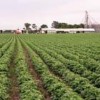 El objetivo de esta publicación EDIS es poner en evidencia los descubrimientos recientes que se enfocan en la ecología de los patógenos humanos en el área de producción de cultivo. Una mejor comprensión de cómo los patógenos persisten fuera de los huéspedes animales en el agua para la agricultura, en el suelo y en las plantas, tendrá grandes impactos en el manejo y procesamiento de los productos mismos, empezando desde el productor y hasta el consumidor. This 3-page fact sheet was written by Massimiliano Marvasi, Max Teplitski, Andrée George, and George Hochmuth, and published by the UF Department of Soil and Water Science, November 2012.
El objetivo de esta publicación EDIS es poner en evidencia los descubrimientos recientes que se enfocan en la ecología de los patógenos humanos en el área de producción de cultivo. Una mejor comprensión de cómo los patógenos persisten fuera de los huéspedes animales en el agua para la agricultura, en el suelo y en las plantas, tendrá grandes impactos en el manejo y procesamiento de los productos mismos, empezando desde el productor y hasta el consumidor. This 3-page fact sheet was written by Massimiliano Marvasi, Max Teplitski, Andrée George, and George Hochmuth, and published by the UF Department of Soil and Water Science, November 2012.
http://edis.ifas.ufl.edu/ss577
Fungicide Resistance Action Committee's (FRAC) Classification Scheme of Fungicides According to Mode of Action (PI94/PI131)
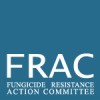 This guide addresses management of pesticide resistance and describes the Fungicide Resistance Action Committee’s (FRAC) classification of fungicides and bactericides registered for agricultural and non-agricultural use in Florida by their modes of action. A cross-reference of common names for active ingredients, along with corresponding examples of their trade names, is also provided. Written by F.M. Fishel and M.M. Dewdney, and published by the UF Department of Agronomy, November 2012.
This guide addresses management of pesticide resistance and describes the Fungicide Resistance Action Committee’s (FRAC) classification of fungicides and bactericides registered for agricultural and non-agricultural use in Florida by their modes of action. A cross-reference of common names for active ingredients, along with corresponding examples of their trade names, is also provided. Written by F.M. Fishel and M.M. Dewdney, and published by the UF Department of Agronomy, November 2012.
http://edis.ifas.ufl.edu/pi131
Diseases of Bitter Melon in South Florida (PP300)
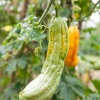 Bitter melon, a tropical and subtropical cucurbit, is widely grown in Asia, Africa, and the Caribbean for its edible fruit. Rich in vitamins A and C, iron, and phosphorus, it contains a compound (charantin) that has been used to lower blood sugar levels to treat diabetes. Two major types of bitter melon, Chinese and Indian, are grown in South Florida year-round. This publication describes common diseases and provides recommendations for their control. This 3-page fact sheet was written by Shouan Zhang, Mary Lamberts, and Gene McAvoy, and published by the UF Department of Plant Pathology, October 2012.
Bitter melon, a tropical and subtropical cucurbit, is widely grown in Asia, Africa, and the Caribbean for its edible fruit. Rich in vitamins A and C, iron, and phosphorus, it contains a compound (charantin) that has been used to lower blood sugar levels to treat diabetes. Two major types of bitter melon, Chinese and Indian, are grown in South Florida year-round. This publication describes common diseases and provides recommendations for their control. This 3-page fact sheet was written by Shouan Zhang, Mary Lamberts, and Gene McAvoy, and published by the UF Department of Plant Pathology, October 2012.
http://edis.ifas.ufl.edu/pp300
Soil pH Range for Optimum Commercial Vegetable Production (HS1207)
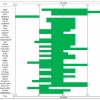 Soil pH affects nutrient bioavailability by controlling the chemical forms of nutrients. This 11-page fact sheet provides information about soil pH basics to commercial growers, county Extension agents, and college students specializing in vegetable production. Written by Guodong Liu and Edward Hanlon, and published by the UF Department of Horticultural Sciences, October 2012.
Soil pH affects nutrient bioavailability by controlling the chemical forms of nutrients. This 11-page fact sheet provides information about soil pH basics to commercial growers, county Extension agents, and college students specializing in vegetable production. Written by Guodong Liu and Edward Hanlon, and published by the UF Department of Horticultural Sciences, October 2012.
http://edis.ifas.ufl.edu/hs1207
Evolution of Citrus Disease Management Programs and Their Economic Implications: The Case of Florida's Citrus Industry (FE915)
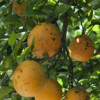 Managing new exotic endemic diseases is very costly, and it is imperative that state and federal governments focus on preventing the introduction of other diseases such as citrus variegataed cholorosis and citrus leprosis virus. This 6-page fact sheet focuses on the expanded costs of managing exotic citrus diseases as they become endemic or established within a citrus industry. Written by Ronald P. Muraro, and published by the UF Department of Food and Resource Economics, October 2012.
Managing new exotic endemic diseases is very costly, and it is imperative that state and federal governments focus on preventing the introduction of other diseases such as citrus variegataed cholorosis and citrus leprosis virus. This 6-page fact sheet focuses on the expanded costs of managing exotic citrus diseases as they become endemic or established within a citrus industry. Written by Ronald P. Muraro, and published by the UF Department of Food and Resource Economics, October 2012.
http://edis.ifas.ufl.edu/fe915
Pesticidas y Colinesterasa (PI242)
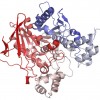 Esta publicación describe la colinesterasa, cómo varios pesticidas de diferentes familias pueden afectar los niveles de colinesterasa en los seres humanos; y la importancia del control oportuno de los niveles de colinesterasa de las personas que manejan pesticidas organofosforados o carbamatos que inhiben la colinesterasa. This 3-page fact sheet was written by Frederick M. Fishel, and published by the UF Department of Agronomy, October 2012.
Esta publicación describe la colinesterasa, cómo varios pesticidas de diferentes familias pueden afectar los niveles de colinesterasa en los seres humanos; y la importancia del control oportuno de los niveles de colinesterasa de las personas que manejan pesticidas organofosforados o carbamatos que inhiben la colinesterasa. This 3-page fact sheet was written by Frederick M. Fishel, and published by the UF Department of Agronomy, October 2012.
http://edis.ifas.ufl.edu/pi242
Multiple-Use Landscapes: Reclaimed Phosphate Mined Lands (SL374/SS575)
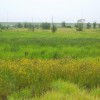 Phosphate mining is a temporary land use. The jobs and economic activity associated with mining depart an area once the resource is exhausted — but the landscape created as a result of mining and reclamation will exist in perpetuity. Communities affected by mining activities need to have reclamation result in lands with high potential to provide sustainable economic opportunities while maintaining ecosystem services and ecological functions. This 8-page fact sheet provides a brief overview of the landscapes being created as a result of phosphate mining and reclamation activities in Florida. Written by M. Wilson and E.A. Hanlon, and published by the UF Department of Soil and Water Science, October 2012.
Phosphate mining is a temporary land use. The jobs and economic activity associated with mining depart an area once the resource is exhausted — but the landscape created as a result of mining and reclamation will exist in perpetuity. Communities affected by mining activities need to have reclamation result in lands with high potential to provide sustainable economic opportunities while maintaining ecosystem services and ecological functions. This 8-page fact sheet provides a brief overview of the landscapes being created as a result of phosphate mining and reclamation activities in Florida. Written by M. Wilson and E.A. Hanlon, and published by the UF Department of Soil and Water Science, October 2012.
http://edis.ifas.ufl.edu/ss575
Una mirada a la produccion, el comercio y el consumo de papaya a nivel mundial (FE917)
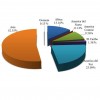 Este artículo provee información referente a las tendencias globales en cuanto a producción, comercio mundial y los países exportadores e importadores de papaya. Written by Edward A. Evans and Fredy H. Ballen, and published by the UF Department of Food and Resource Economics, October 2012.
Este artículo provee información referente a las tendencias globales en cuanto a producción, comercio mundial y los países exportadores e importadores de papaya. Written by Edward A. Evans and Fredy H. Ballen, and published by the UF Department of Food and Resource Economics, October 2012.
http://edis.ifas.ufl.edu/fe917
Production Systems: Florida Greenhouse Vegetable Production Handbook, Vol 3 (HS785/CV263)
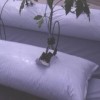 Worldwide, commercial greenhouse vegetable producers currently use numerous production systems. Among the more prevalent include lay-flat bag or upright container culture, trough culture, rockwool, vertical culture, nutrient film technique (NFT), and ground (in-soil) culture. Many modifications of these basic production systems are presently in use, and most are appropriate for Florida, except for unamended ground culture. This 8-page fact sheet was written by Dan Fenneman, Michael Sweat, George Hochmuth, and Robert Hochmuth, and published by the UF Department of Horticultural Sciences, October 2012.
Worldwide, commercial greenhouse vegetable producers currently use numerous production systems. Among the more prevalent include lay-flat bag or upright container culture, trough culture, rockwool, vertical culture, nutrient film technique (NFT), and ground (in-soil) culture. Many modifications of these basic production systems are presently in use, and most are appropriate for Florida, except for unamended ground culture. This 8-page fact sheet was written by Dan Fenneman, Michael Sweat, George Hochmuth, and Robert Hochmuth, and published by the UF Department of Horticultural Sciences, October 2012.
http://edis.ifas.ufl.edu/cv263
Aquatic Toxicology Notes: Endothall (SL369/SS570)
 Endothall is the herbicidal active ingredient found in commercial formulations labeled for weed control in aquatic systems and on ditch banks. It is also used as a defoliant and desiccant in some terrestrial situations (e.g., in potato, hops, cotton, clover, and alfalfa production). This 7-page fact sheet introduces users of endothall to the physical, chemical, environmental, and ecological properties of this herbicidal active ingredient relative to the aquatic environment. Written by P. Chris Wilson and Jun Wu, and published by the UF Department of Soil and Water Science, October 2012.
Endothall is the herbicidal active ingredient found in commercial formulations labeled for weed control in aquatic systems and on ditch banks. It is also used as a defoliant and desiccant in some terrestrial situations (e.g., in potato, hops, cotton, clover, and alfalfa production). This 7-page fact sheet introduces users of endothall to the physical, chemical, environmental, and ecological properties of this herbicidal active ingredient relative to the aquatic environment. Written by P. Chris Wilson and Jun Wu, and published by the UF Department of Soil and Water Science, October 2012.
http://edis.ifas.ufl.edu/ss570
Aquatic Toxicology Notes: Diquat (SL368/SS569)
 Diquat is applied directly to plants along ditch banks and within aquatic systems. It may also be applied to ponds, lakes, and drainage ditches to control algae and submersed aquatic weeds. This 7-page fact sheet introduces users of diquat to the physical, chemical, environmental, and ecological properties of this herbicidal active ingredient relative to the aquatic environment. Written by P. Chris Wilson and Jun Wu, and published by the UF Department of Soil and Water Science, October 2012.
Diquat is applied directly to plants along ditch banks and within aquatic systems. It may also be applied to ponds, lakes, and drainage ditches to control algae and submersed aquatic weeds. This 7-page fact sheet introduces users of diquat to the physical, chemical, environmental, and ecological properties of this herbicidal active ingredient relative to the aquatic environment. Written by P. Chris Wilson and Jun Wu, and published by the UF Department of Soil and Water Science, October 2012.
http://edis.ifas.ufl.edu/ss569
Florida Crop/Pest Management Profiles: Snap Beans (CIR1231/PI032)
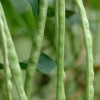 In 2009-2010, Florida growers produced 193.2 million pounds of snap beans, with a value of $0.69 per pound and a total value of $135 million. Snap beans were planted on 36,400 acres, and 32,200 acres were harvested, yielding an average of 6,000 pounds per acre. This 18-page fact sheet was written by W.M. Elwakil and Mark A. Mossler, and published by the UF Department of Agronomy, October 2012.
In 2009-2010, Florida growers produced 193.2 million pounds of snap beans, with a value of $0.69 per pound and a total value of $135 million. Snap beans were planted on 36,400 acres, and 32,200 acres were harvested, yielding an average of 6,000 pounds per acre. This 18-page fact sheet was written by W.M. Elwakil and Mark A. Mossler, and published by the UF Department of Agronomy, October 2012.
http://edis.ifas.ufl.edu/pi032
Comparing the Urine Ketone Strip Test and Handheld Ketone Meter to Diagnose Ketosis in Early Lactation Dairy Cows (VM186)
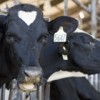 Ketosis is a common metabolic disease in fresh dairy cows. Clinical and subclinical ketosis (SCK) can cause reduced milk yield, decreased milk protein, reduced reproductive capacity, and increased risk of displaced abomasum. Usually, diagnosing ketosis is performed by measuring acetoacetate or BHBA levels in the blood, urine, or milk samples. Measuring BHBA in serum or plasma is considered the gold standard diagnostic test for subclinical ketosis, because this method has stability, but the price for ketone strips is approximately $0.08/strip while the price for the the electronic BHBA measuring system is approximately $1.00. UF/IFAS researchers conducted a study to compare the two, using 72 Holstein cows between 14–40 days in milk from three dairy farms in north-central Florida with 450–800 lactating dairy cows. The key finding for this experiment is that no difference exists in BHBA concentration between cows that had a trace or small in the ketone strip reading. This 3-page fact sheet was written by Klibs N. Galvão, Achilles Vieira Neto, Gustavo Peña, Joao Bittar, and Lucas Ibarbia, and published by the UF Department of Veterinary Medicine-Large Animal Clinical Sciences, October 2012.
Ketosis is a common metabolic disease in fresh dairy cows. Clinical and subclinical ketosis (SCK) can cause reduced milk yield, decreased milk protein, reduced reproductive capacity, and increased risk of displaced abomasum. Usually, diagnosing ketosis is performed by measuring acetoacetate or BHBA levels in the blood, urine, or milk samples. Measuring BHBA in serum or plasma is considered the gold standard diagnostic test for subclinical ketosis, because this method has stability, but the price for ketone strips is approximately $0.08/strip while the price for the the electronic BHBA measuring system is approximately $1.00. UF/IFAS researchers conducted a study to compare the two, using 72 Holstein cows between 14–40 days in milk from three dairy farms in north-central Florida with 450–800 lactating dairy cows. The key finding for this experiment is that no difference exists in BHBA concentration between cows that had a trace or small in the ketone strip reading. This 3-page fact sheet was written by Klibs N. Galvão, Achilles Vieira Neto, Gustavo Peña, Joao Bittar, and Lucas Ibarbia, and published by the UF Department of Veterinary Medicine-Large Animal Clinical Sciences, October 2012.
http://edis.ifas.ufl.edu/vm186